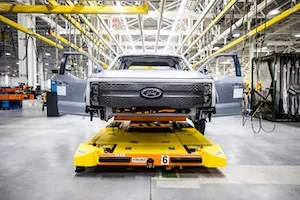Texas Dan
Well-known member
- Thread starter
- #1
With the towing capacity of up to 10,000 lbs., it's easy to imagine hooking up a big travel trailer and taking off cross country in a F150 Lightning. The biggest problem with RVing an EV today is that the world is not designed to cater to RV EVs. Even ICE RVs have trouble finding long enough fueling stations and the fast charging stations that we have now just are not designed for long RVs.
Fueling stations that cater to longer vehicles, such as Flying J and Loves, have been developing fueling station designs for decades. To these companies gas and diesel are still king. It might be another decade before these big fueling stations start designing stations around large EV charging.
If we want to hook a big travel trailer up to our F150 Lightning how do we charge it on a long cross country trip? One option I see is to disconnect the trailer in a big parking lot such as a Walmart that has an Electrify America station. This might actually be a preferred option since the family can enjoy the travel trailer while the truck charges.
Another option is to park and charge over night at RV parks. We would probably be staying overnight in an RV park anyway so we might as well charge up while sleeping. Unfortunately with the F150 Lightning you will only be able to get about a half a charge overnight using the standard NEMA 14-50 RV outlet but maybe that would be enough to get to the closest fast charger.
Just like with any EV travel it will pay to plan ahead and to be patient. There is lots of good advice on fueling an RV on the internet and I think a lot of this information will be useful in charging up a long RV EV. Some of us will want to wait until the world catches up to RV EVs but by then the early adopters will have EV RVing all figured out.
So what are your thoughts? Are you ready to hook up a travel trailer to your F150 Lightning and head off into the sunset? Have you thought about how you would keep an F150 Lightning pulling a big travel trailer charged on long trips?
Fueling stations that cater to longer vehicles, such as Flying J and Loves, have been developing fueling station designs for decades. To these companies gas and diesel are still king. It might be another decade before these big fueling stations start designing stations around large EV charging.
If we want to hook a big travel trailer up to our F150 Lightning how do we charge it on a long cross country trip? One option I see is to disconnect the trailer in a big parking lot such as a Walmart that has an Electrify America station. This might actually be a preferred option since the family can enjoy the travel trailer while the truck charges.
Another option is to park and charge over night at RV parks. We would probably be staying overnight in an RV park anyway so we might as well charge up while sleeping. Unfortunately with the F150 Lightning you will only be able to get about a half a charge overnight using the standard NEMA 14-50 RV outlet but maybe that would be enough to get to the closest fast charger.
Just like with any EV travel it will pay to plan ahead and to be patient. There is lots of good advice on fueling an RV on the internet and I think a lot of this information will be useful in charging up a long RV EV. Some of us will want to wait until the world catches up to RV EVs but by then the early adopters will have EV RVing all figured out.
So what are your thoughts? Are you ready to hook up a travel trailer to your F150 Lightning and head off into the sunset? Have you thought about how you would keep an F150 Lightning pulling a big travel trailer charged on long trips?
Sponsored



